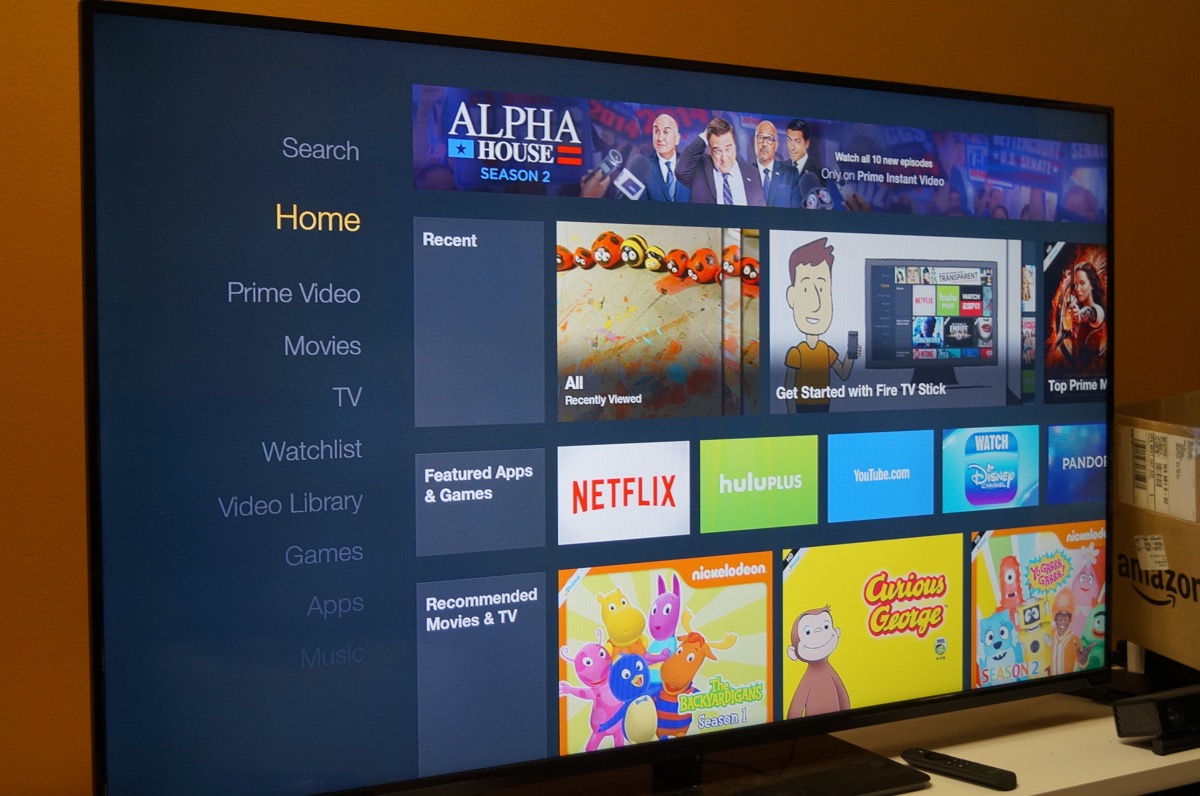Home>Technology>Home Entertainment Systems>How To Advertise On Television


Home Entertainment Systems
How To Advertise On Television
Published: December 21, 2023
Learn how to effectively advertise your home entertainment systems on television and reach a wider audience. Discover the best strategies for TV advertising success.
(Many of the links in this article redirect to a specific reviewed product. Your purchase of these products through affiliate links helps to generate commission for Storables.com, at no extra cost. Learn more)
Introduction
Television advertising has long been a cornerstone of marketing strategies for businesses seeking to reach a wide audience. In the ever-evolving landscape of advertising, television remains a powerful medium for captivating viewers and conveying impactful messages. This article will delve into the intricacies of television advertising, providing valuable insights and practical tips for businesses looking to harness the potential of this dynamic platform.
Television advertisements have the unique ability to engage audiences through compelling visuals, captivating narratives, and persuasive messaging. With the potential to reach millions of viewers, television advertising offers an unparalleled opportunity to showcase products and services on a grand scale. However, navigating the realm of television advertising requires a strategic approach, an understanding of audience dynamics, and a keen eye for effective storytelling.
In this comprehensive guide, we will explore the fundamental aspects of television advertising, from setting clear advertising goals to creating impactful advertisements that resonate with viewers. Additionally, we will delve into the process of identifying target audiences, selecting the right television networks for optimal reach, and negotiating ad space and time slots to maximize the impact of your advertising campaigns.
Whether you are a seasoned marketer or a business owner venturing into the realm of television advertising for the first time, this guide aims to equip you with the knowledge and strategies needed to make informed decisions and achieve tangible results. By understanding the nuances of television advertising and leveraging its inherent strengths, businesses can amplify their brand visibility, drive consumer engagement, and ultimately, propel their growth in a competitive marketplace.
Join us on this journey as we unravel the art and science of television advertising, uncovering the strategies that can elevate your brand presence and resonate with audiences in the digital age. Let's embark on a captivating exploration of television advertising and unlock the potential to captivate viewers, drive brand recognition, and achieve marketing success.
Key Takeaways:
- Television advertising is a powerful way for businesses to reach a wide audience through captivating visuals and storytelling, helping to boost brand visibility and drive consumer engagement on a grand scale.
- To succeed in television advertising, businesses need to set clear advertising goals, identify their target audience, and create compelling narratives that resonate with viewers, ultimately driving tangible marketing outcomes.
Read more: Why Is Television Advertising Effective
Understanding Television Advertising
Television advertising encompasses the strategic promotion of products, services, or brands through television channels, leveraging visual and auditory elements to engage audiences. This form of advertising is designed to capture viewers’ attention, convey persuasive messages, and influence consumer behavior. Understanding the dynamics of television advertising involves recognizing its unique strengths, audience reach, and the impact of visual storytelling.
One of the primary advantages of television advertising is its unparalleled ability to create immersive and visually compelling narratives. Through the combination of sight, sound, and motion, television advertisements have the potential to evoke emotional responses, leaving a lasting impression on viewers. Whether through captivating storytelling, memorable jingles, or striking visuals, television ads can forge strong connections with audiences, fostering brand recognition and consumer loyalty.
Moreover, television advertising offers extensive reach, allowing businesses to connect with diverse demographics across geographical locations. With the proliferation of cable and satellite television, advertisers can target specific regions or nationwide audiences, tailoring their messages to resonate with distinct consumer segments. This broad reach enables brands to amplify their market presence, generate widespread awareness, and establish a compelling brand identity in the minds of consumers.
Another crucial aspect of understanding television advertising lies in recognizing the impact of visual and auditory stimuli on consumer perception. Well-crafted television ads have the potential to convey complex messages in a succinct and impactful manner, leveraging the power of audio-visual storytelling to communicate brand values, product benefits, and compelling calls to action. By harnessing the emotive potential of audio-visual content, advertisers can elicit strong emotional responses, shape consumer attitudes, and drive favorable purchase decisions.
Furthermore, television advertising plays a pivotal role in shaping cultural conversations and influencing societal trends. Iconic television commercials have the ability to become ingrained in popular culture, transcending mere advertising to become part of collective memory. Memorable ad campaigns can spark discussions, inspire social movements, and leave a lasting imprint on the cultural fabric, underscoring the profound influence of television advertising on shaping public discourse and consumer behaviors.
As we delve deeper into the realm of television advertising, it becomes evident that this dynamic medium holds immense potential for businesses to engage, inspire, and resonate with audiences on a profound level. By understanding the multifaceted impact of television advertising, businesses can leverage its strengths to craft compelling narratives, foster brand loyalty, and drive meaningful connections with consumers.
Setting Your Advertising Goals
Before embarking on a television advertising campaign, it is essential for businesses to define clear and measurable advertising goals that align with their overall marketing objectives. Setting precise advertising goals serves as a guiding framework, allowing businesses to focus their efforts, allocate resources effectively, and gauge the success of their television ad campaigns. Whether aiming to boost brand awareness, drive sales, or launch new products, establishing well-defined advertising goals is a critical first step in leveraging the power of television advertising.
One of the primary objectives of television advertising is to enhance brand visibility and recognition. By setting the goal of increasing brand awareness, businesses strive to elevate their market presence, imprint their brand identity in the minds of consumers, and foster familiarity with their products or services. This goal is particularly pertinent for emerging brands seeking to carve a distinct niche in competitive markets or for established companies aiming to reinforce their brand image and maintain top-of-mind recall among consumers.
Another pivotal advertising goal often pursued through television campaigns is driving sales and revenue generation. Whether promoting specific products, highlighting limited-time offers, or showcasing unique selling propositions, television advertisements can serve as potent catalysts for driving consumer engagement and purchase intent. By setting clear targets for sales growth, businesses can measure the direct impact of their television ad campaigns on driving conversions, increasing customer acquisition, and ultimately, boosting revenue streams.
Beyond immediate sales impact, television advertising can also be leveraged to shape consumer perceptions, instill brand loyalty, and cultivate long-term customer relationships. Setting advertising goals focused on brand affinity and consumer loyalty entails creating narratives that resonate emotionally, align with brand values, and foster ongoing engagement with the target audience. By aiming to build enduring connections with consumers, businesses can use television advertising as a platform to cultivate brand advocates, nurture customer loyalty, and foster a community of dedicated brand supporters.
Furthermore, for businesses introducing new products or venturing into untapped markets, television advertising can serve as a strategic tool for product launches and market penetration. Setting advertising goals centered on product introduction involves creating buzz, generating curiosity, and positioning new offerings in the minds of consumers. Through compelling storytelling and impactful visuals, television ads can introduce new products to audiences, educate consumers about their unique value propositions, and stimulate early adoption and purchase consideration.
In essence, setting clear advertising goals is fundamental to the success of television advertising campaigns, providing a roadmap for businesses to channel their resources, craft compelling narratives, and measure the impact of their advertising endeavors. By aligning advertising goals with overarching marketing objectives, businesses can harness the persuasive potential of television advertising to amplify brand visibility, drive sales, cultivate consumer loyalty, and propel their growth in competitive market landscapes.
Identifying Your Target Audience
Central to the success of any television advertising campaign is the precise identification of the target audience – the demographic, psychographic, and behavioral profiles of the viewers who are most likely to be receptive to the advertising message. Understanding the nuances of the target audience enables businesses to tailor their television advertisements with precision, effectively engage potential consumers, and maximize the impact of their marketing efforts.
One of the primary considerations in identifying the target audience for television advertising is demographic segmentation. This involves categorizing viewers based on quantifiable attributes such as age, gender, income level, education, occupation, and geographic location. By analyzing demographic data, businesses can pinpoint the specific segments of the population that align with their product offerings, ensuring that their television advertisements resonate with the intended consumer demographics and cater to their unique needs and preferences.
Beyond demographic factors, psychographic segmentation plays a crucial role in understanding the psychological and lifestyle characteristics of the target audience. Psychographic variables encompass elements such as values, attitudes, interests, hobbies, personality traits, and cultural influences. By delving into the psychographic profiles of viewers, businesses can tailor their television ads to align with the aspirations, beliefs, and lifestyle choices of their target consumers, forging deeper connections and resonating with their underlying motivations and desires.
Furthermore, behavioral segmentation entails analyzing consumer behaviors, purchase patterns, brand interactions, and media consumption habits. By understanding the behavioral tendencies of the target audience, businesses can craft television advertisements that align with consumers’ purchasing propensities, content consumption preferences, and engagement habits. This approach allows advertisers to deliver tailored messages that speak directly to the specific behaviors and inclinations of their intended audience, fostering relevance and resonance.
Another pivotal aspect of identifying the target audience for television advertising involves considering the viewers’ media consumption habits and preferences. Understanding which television networks, channels, or programs are frequented by the target audience provides valuable insights for selecting the most relevant platforms to showcase advertisements. By aligning the placement of television ads with the viewing habits of the target audience, businesses can optimize their reach, ensuring that their messages are delivered in contexts that resonate with viewers’ interests and preferences.
Ultimately, the process of identifying the target audience for television advertising revolves around gaining a comprehensive understanding of the consumers who are most likely to be receptive to the advertising message. By leveraging demographic, psychographic, and behavioral insights, businesses can tailor their television advertisements to resonate with the unique characteristics, preferences, and behaviors of their target audience, maximizing the efficacy of their advertising campaigns and fostering meaningful connections with potential consumers.
Choosing the Right Television Network
When devising a television advertising strategy, selecting the appropriate television network to showcase your advertisements is a pivotal decision that can significantly impact the reach, relevance, and resonance of your marketing campaigns. The diverse landscape of television networks, spanning national, regional, and niche channels, offers businesses a multitude of opportunities to connect with specific audience segments and align their advertisements with relevant content. By carefully evaluating the characteristics of different television networks, businesses can strategically position their ads to maximize visibility and engagement among their target audience.
One of the primary considerations in choosing the right television network is assessing the network’s viewership demographics and audience composition. Understanding the demographic profiles of viewers who tune in to a particular network is essential for aligning your advertisements with the characteristics of your target audience. Whether targeting specific age groups, gender demographics, income brackets, or geographic regions, selecting a television network that closely mirrors the attributes of your ideal consumers enhances the relevance and impact of your advertising efforts.
Beyond demographic considerations, the content and programming offered by different television networks play a crucial role in determining their suitability for showcasing your advertisements. Assessing the genres, themes, and formats of the programs aired on a network enables businesses to align their advertisements with content that resonates with their target audience. Whether seeking to reach sports enthusiasts, lifestyle aficionados, news consumers, or entertainment seekers, choosing a television network that hosts programming aligned with your target consumers’ interests enhances the contextual relevance and engagement potential of your advertisements.
Moreover, the geographic reach and coverage area of a television network are pivotal factors to consider, particularly for businesses targeting specific regional markets or aiming to achieve nationwide visibility. Assessing the network’s reach, coverage zones, and audience distribution allows businesses to tailor their advertising placements to align with their regional or national marketing objectives. Whether seeking localized impact or broader market saturation, choosing a television network with the appropriate geographic footprint ensures that your advertisements resonate with audiences in the desired locations.
Another aspect to consider when choosing the right television network is the network’s brand image, reputation, and audience engagement levels. Evaluating the perceived quality, credibility, and viewership engagement of a network provides insights into the contextual environment in which your advertisements will be showcased. Aligning your brand with networks that uphold a positive brand image and foster high levels of viewer trust and engagement can enhance the perceived credibility and impact of your advertisements, contributing to a more favorable reception among the audience.
Ultimately, the process of choosing the right television network for your advertising endeavors involves a comprehensive assessment of the network’s viewership demographics, programming content, geographic coverage, and brand attributes. By aligning your advertisements with networks that resonate with your target audience, contextualize your messaging, and uphold a positive brand environment, businesses can optimize the impact and effectiveness of their television advertising campaigns, fostering meaningful connections with consumers and driving tangible marketing outcomes.
Consider the timing of your TV ads to reach your target audience. Research when your audience is most likely to be watching TV and schedule your ads accordingly.
Creating Your Television Advertisement
The process of crafting a compelling television advertisement involves weaving together captivating visuals, persuasive messaging, and emotive storytelling to engage viewers and leave a lasting impression. From conceptualization to production, creating a television ad that resonates with audiences requires a meticulous blend of creativity, strategic messaging, and visual artistry. By embracing the unique storytelling potential of television, businesses can captivate viewers, convey brand narratives, and inspire consumer action through impactful advertisements.
One of the foundational elements in creating a television advertisement is the development of a compelling narrative that resonates with the target audience. Whether evoking emotions, showcasing real-life scenarios, or presenting aspirational stories, the narrative of a television ad serves as the cornerstone for engaging viewers and conveying the essence of the brand or product. Crafting a narrative that aligns with the brand’s values, addresses consumer needs, and elicits an emotional response establishes a powerful connection with the audience, fostering brand affinity and recognition.
Visual storytelling lies at the heart of television advertising, leveraging the power of imagery, cinematography, and visual effects to convey compelling messages. From striking visuals that capture attention to seamless transitions that maintain viewer engagement, the visual components of a television ad play a pivotal role in conveying brand aesthetics, product features, and the overarching narrative. By harnessing the emotive potential of visual storytelling, businesses can create advertisements that resonate with viewers on a visceral level, leaving a lasting imprint in their minds.
Persuasive messaging forms the backbone of effective television advertisements, encapsulating the core value propositions, calls to action, and brand promises in succinct and impactful statements. Crafting persuasive messaging involves distilling the essence of the brand or product into memorable taglines, compelling slogans, and persuasive narratives that resonate with the target audience. Whether aiming to inspire action, evoke curiosity, or drive brand recall, the messaging in a television ad serves as a catalyst for shaping consumer perceptions and influencing purchasing behaviors.
Furthermore, the audio elements of a television advertisement, including voiceovers, soundtracks, and sound effects, contribute to the overall emotive impact and memorability of the ad. Strategic use of audio elements can enhance the storytelling experience, evoke specific emotions, and reinforce the messaging, creating a multi-sensory engagement that resonates with viewers on both conscious and subconscious levels. By harmonizing visual and auditory elements, businesses can create television advertisements that leave a lasting auditory and visual imprint, fostering brand recall and consumer resonance.
In essence, creating a compelling television advertisement involves a harmonious fusion of captivating narratives, visual artistry, persuasive messaging, and emotive audio elements. By leveraging the unique storytelling potential of television, businesses can craft advertisements that transcend mere promotion to become immersive brand experiences, leaving an indelible mark on viewers and fostering enduring connections with consumers.
Negotiating Ad Space and Time Slots
Securing optimal ad space and strategically timed slots for television advertisements is a critical component of a successful television advertising strategy. The negotiation process for ad space and time slots involves navigating a dynamic marketplace, understanding viewership patterns, and leveraging strategic placements to maximize the reach and impact of advertisements. By engaging in astute negotiations and strategic planning, businesses can position their ads to capture the attention of their target audience and achieve optimal visibility and resonance.
One of the primary considerations in negotiating ad space is evaluating the viewership metrics and audience demographics of specific time slots and programs. Understanding the viewership patterns, peak audience engagement times, and demographic compositions of different time slots enables businesses to align their ad placements with the periods when their target audience is most likely to be tuned in. By selecting time slots that correspond to peak viewership among the desired demographic segments, businesses can optimize the visibility and impact of their advertisements, ensuring that their messages reach the intended audience with maximum efficacy.
Beyond viewership metrics, negotiating ad space involves assessing the competitive landscape and demand for specific time slots across different television networks. Understanding the pricing dynamics, availability of prime ad slots, and competitive positioning of other advertisers provides valuable insights for securing optimal placements. By leveraging market insights and engaging in strategic negotiations, businesses can secure ad space that aligns with their budgetary considerations, marketing objectives, and audience reach requirements, ensuring that their advertisements are positioned for maximum impact.
Strategic negotiation for ad space also entails considering the contextual relevance and thematic alignment of specific programs and time slots with the brand or product being advertised. By aligning ad placements with programs that resonate with the target audience’s interests, preferences, and psychographic profiles, businesses can enhance the contextual relevance and engagement potential of their advertisements. Negotiating placements within programs that align with the brand’s values, product themes, or consumer aspirations fosters a deeper resonance with viewers, maximizing the effectiveness of the ad placements.
Moreover, negotiating ad space and time slots involves exploring opportunities for strategic bundling, package deals, and added value offerings from television networks or media agencies. By leveraging negotiations to secure bundled ad packages, premium placements, or value-added benefits such as extended airtime, businesses can optimize their advertising investments and amplify the impact of their television ad campaigns. Strategic negotiations can unlock opportunities for enhanced visibility, extended reach, and heightened engagement, empowering businesses to maximize the returns on their advertising endeavors.
In essence, negotiating ad space and time slots for television advertisements requires a strategic blend of market insights, audience understanding, and astute negotiation skills. By aligning ad placements with peak viewership times, contextual relevance, and strategic bundling opportunities, businesses can position their advertisements for optimal visibility, resonance, and impact, driving tangible outcomes and fostering meaningful connections with their target audience.
Measuring the Effectiveness of Your Television Advertisements
Assessing the impact and efficacy of television advertisements is essential for businesses to gauge the success of their marketing endeavors, optimize their strategies, and refine future campaigns. Measuring the effectiveness of television advertisements involves employing a range of metrics, analytics tools, and performance indicators to evaluate audience engagement, brand lift, and the attainment of marketing objectives. By leveraging comprehensive measurement approaches, businesses can gain valuable insights into the performance of their television ad campaigns and make data-driven decisions to enhance their advertising strategies.
One of the fundamental metrics for measuring the effectiveness of television advertisements is reach and frequency, which quantifies the extent of audience exposure to the ad and the frequency of its broadcast. By analyzing reach metrics, businesses can assess the breadth of their ad’s visibility and its penetration into the target audience segments. Additionally, evaluating the frequency of ad airings enables businesses to understand the level of repetition and reinforcement of their messaging, providing insights into the ad’s potential to leave a lasting impression on viewers.
Brand awareness and recall metrics serve as pivotal indicators of the impact of television advertisements on consumer perceptions. Surveys, brand recognition studies, and recall tests can provide valuable data on the extent to which the ad has contributed to elevating brand awareness, fostering brand recall, and shaping consumer attitudes. By gauging brand awareness and recall metrics, businesses can assess the ad’s ability to imprint the brand in the minds of consumers and drive favorable associations and recognition.
Furthermore, analyzing audience engagement metrics, such as viewer retention, ad interaction rates, and response mechanisms, offers insights into the level of viewer engagement and receptivity to the advertisement. By evaluating audience engagement metrics, businesses can discern the degree to which the ad captivates viewers, sustains their attention, and prompts them to take desired actions, such as visiting a website, making inquiries, or engaging with the brand on social media. These metrics provide valuable indicators of the ad’s ability to foster meaningful interactions and drive consumer engagement.
Effectiveness in driving tangible outcomes, such as sales uplift, website traffic, or lead generation, serves as a pivotal measure of the ad’s impact on consumer behavior. By correlating ad airings with sales data, website analytics, or lead conversion rates, businesses can discern the direct impact of the television ad on driving consumer actions and purchase intent. Understanding the correlation between ad exposure and consumer response enables businesses to gauge the ad’s effectiveness in driving tangible outcomes and influencing purchasing behaviors.
Moreover, leveraging advanced analytics tools, such as attribution modeling, multi-touch attribution, and media mix modeling, can provide comprehensive insights into the holistic impact of television advertisements on overall marketing performance. By employing sophisticated analytics approaches, businesses can discern the interplay of television advertising with other marketing channels, assess its contribution to the overall marketing mix, and optimize resource allocation for maximum impact and return on investment.
In essence, measuring the effectiveness of television advertisements encompasses a multifaceted approach, incorporating reach metrics, brand awareness and recall, audience engagement indicators, consumer behavior outcomes, and advanced analytics methodologies. By harnessing a comprehensive suite of measurement tools, businesses can gain nuanced insights into the performance of their television ad campaigns, refine their strategies, and optimize their advertising investments to drive tangible outcomes and foster enduring connections with consumers.
Conclusion
Television advertising stands as a dynamic and influential medium that empowers businesses to engage audiences, convey compelling narratives, and amplify brand visibility on a grand scale. Throughout this comprehensive guide, we have navigated the multifaceted landscape of television advertising, exploring the nuances of strategic planning, audience engagement, and the measurement of advertising effectiveness. As businesses venture into the realm of television advertising, it is imperative to recognize the profound impact of this medium in shaping consumer perceptions, fostering brand resonance, and driving tangible marketing outcomes.
Understanding the art and science of television advertising entails a strategic approach to setting clear advertising goals, identifying the target audience, and crafting compelling narratives that resonate with viewers. By aligning advertising objectives with audience dynamics and leveraging the emotive potential of visual storytelling, businesses can create advertisements that captivate audiences, foster enduring connections, and drive meaningful engagement.
Choosing the right television network for ad placements, negotiating optimal ad space and time slots, and measuring the impact of television advertisements are pivotal aspects of a successful advertising strategy. By aligning ad placements with the viewership patterns, contextual relevance, and strategic bundling opportunities, businesses can position their advertisements for maximum visibility, resonance, and impact, driving tangible outcomes and fostering meaningful connections with their target audience.
As businesses navigate the realm of television advertising, it is essential to embrace a data-driven approach to measure the effectiveness of ad campaigns, leveraging comprehensive metrics, analytics tools, and advanced methodologies to assess audience engagement, brand lift, and the attainment of marketing objectives. By harnessing a comprehensive suite of measurement tools, businesses can gain nuanced insights into the performance of their television ad campaigns, refine their strategies, and optimize their advertising investments to drive tangible outcomes and foster enduring connections with consumers.
In the ever-evolving landscape of marketing and advertising, television remains a formidable platform for businesses to showcase their products, convey impactful messages, and forge enduring connections with consumers. By understanding the intricacies of television advertising and harnessing its inherent strengths, businesses can amplify their brand visibility, drive consumer engagement, and ultimately, propel their growth in a competitive marketplace. As we embark on this captivating exploration of television advertising, let us embrace the art of storytelling, the precision of strategic planning, and the transformative potential of television advertising to captivate audiences, inspire action, and achieve marketing success.
Frequently Asked Questions about How To Advertise On Television
Was this page helpful?
At Storables.com, we guarantee accurate and reliable information. Our content, validated by Expert Board Contributors, is crafted following stringent Editorial Policies. We're committed to providing you with well-researched, expert-backed insights for all your informational needs.















0 thoughts on “How To Advertise On Television”